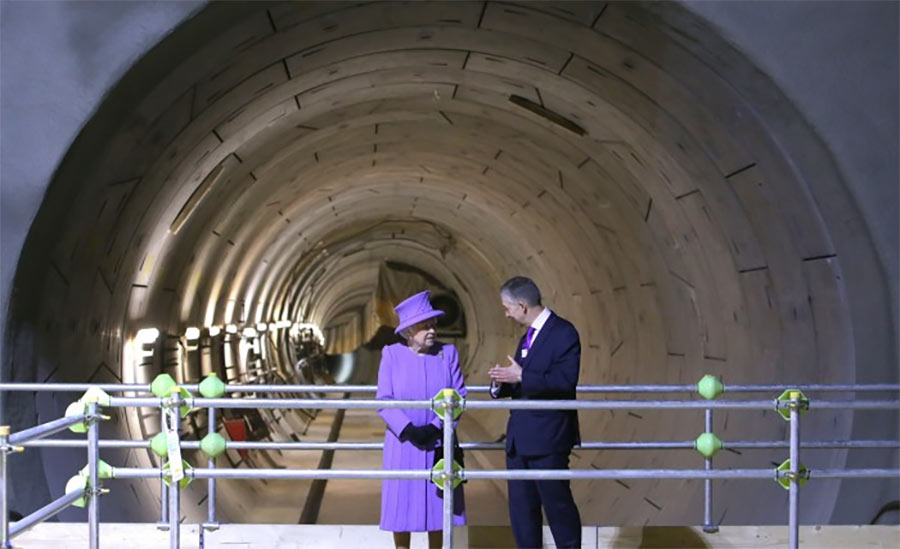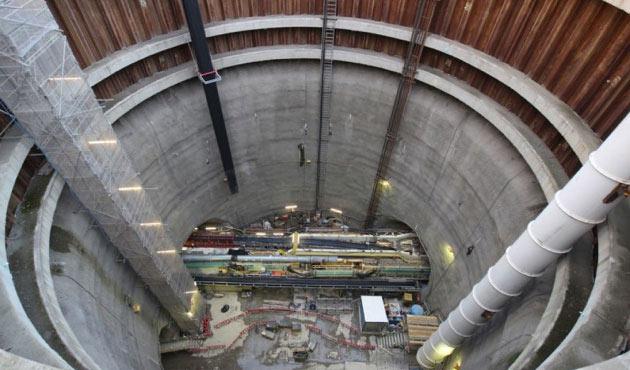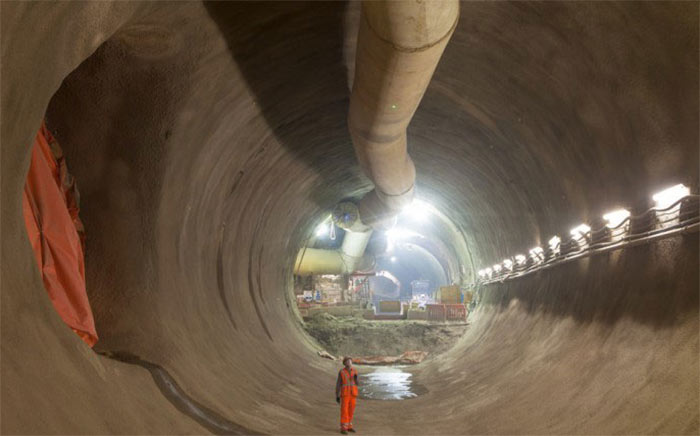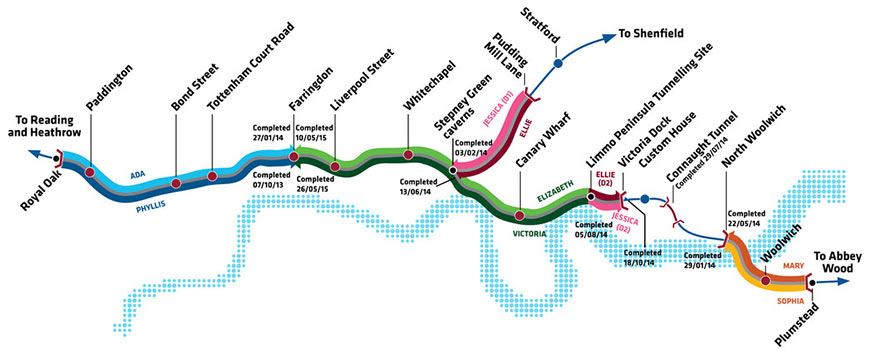Yet more money agreed to complete Crossrail 03 Dec 2020
Another £835 million in the form of borrowings has been secured to complete the delayed Crossrail project in London. This is part of the £1.1 billion in extra funding that Crossrail estimated would be needed in August 2020 and is in addition to the £2.8 billion extra announced in December 2018 when the scheduled opening of the new railway was missed, and the $200 million agreed in July 2019 for Crossrail works by Network Rail.
The capital cost of the project now stands at £18.6 billion, from the £15.9 billion estimate in 2007, which was cut to £14.8 billion in 2010 as part of a UK Government spending review; and the anticipated opening date for the central underground section of the 118km long railway is first half of 2022. Crossrail services on the overground section from Paddington to Reading and from Paddington to Heathrow in the west, and from Liverrpool Street Station to Shenfield in the east started in December 2019. The project is funded almost entirely by public taxpayer money with some private capital invested in the stations at Woolwich and Canary Wharf.
Work on the project started in early 2009 with the establishment of the private sector Crossrail Ltd Project Delivery Partner of Bechtel, Halcrow Group (now Jacobs) and Systra, and Programme Partner of AECOM, CH2M Hill (now Jacobs) and the Nichols Group to coordinate the various parts of project.
Work on the underground sections began in August 2009 with start of design-build contract awards for 24km of segmentally-lined twin running tunnels (48km in total) and seven new underground stations, two open-cut and five SCL mined excavations (Fig 1). The design-build contract for the twin tube section under the River Thames in the east was awarded in April 2011 and the last of the underground station contracts for Bond Street Station was awarded in February 2013 (see Reference list below).
| Table 1. Crossrail tunnel drive details and progress | |||||
| TBM | Launch | Location | Distance | Completion | Contractor |
| Phyllis (EPBM) | 4 May 2012 | Royal Oak-Farringdon (Drive X) | 6,400m | 10 Oct 2013 | BAM Nuttall/ Ferrovial Agroman/ Kier |
| Ada (EPBM) | 21 Aug 2012 | Royal Oak-Farringdon (Drive X) | 6,400m | 24 Jan 2014 | BAM Nuttall/ Ferrovial Agroman/ Kier |
| Elizabeth (EPBM) | 29 Nov 2012 | Limmo (Docklands) - Farringdon (Drive Y) |
8,300m | 11 May 2015 | Dragados/Sisk |
| Victoria (EPBM) | 8 Dec 2012 | Limmo (Docklands) - Farringdon (Drive Y) |
8,300m | 26 May 2015 | Dragados/Sisk |
| Jessica (EPBM) | 2 June 2014 | Limmo-Victoria Dock (Drive G) | 900m | 9 Aug 2014 | Dragados/Sisk |
| Ellie (EPBM) | 11 Sep 2014 | Limmo--Victoria Dock (Drive G) | 900m | 18 Oct 2014 | Dragados/Sisk |
| Sophia (slurry TBM) | 9 Jan 2013 | Plumstead-Woolwich (Drive H - under River Thames) | 3,000m | 29 Jan 2014 | Hochtief/ Murphy |
| Mary (slurry TBM) | 19 May 2013 | Plumstead-Woolwich (Drive H - under River Thames) | 3,000m | 13 May 2014 | Hochtief/ Murphy |
| Jessica (EPBM) | 15 Aug 2013 | Pudding Mill Lane-Stepney Green (Drive Z) | 2,700m | 3 Feb 2014 | Dragados/ Sisk |
| Ellie (EPBM) | 25 Feb 2014 | Pudding Mill Lane-Stepney Green (Drive Z) | 2,700m | 9 June 2014 | Dragados/ Sisk |
With concentration by the project and the public on the underground excavation works, the first TBM of a total eight machines was launched at the Royal Oak portal to the east in May 2012 to drive through the station box at Paddington and the mined station zones at Bond Street and Tottenham Court Road. The shields of the twin drives were then driven off-line at the Farringdon Station interface and buried, once the internal components were retrieved back at the Royal Oak portal. Completion of SCL excavation of the platform tunnels at Whitechapel Station allowed the last two TBMs on the project to continue their journey, through the Liverpool Street SCL station zone and record the last TBM breakthroughs at Farringdon in May 2015. The achievements were celebrated at the time by then UK Prime Minister David Cameron and Mayor of London (now UK Prime Minister) Boris Johnson. Her Majesty Queen Elizabeth II also acknowledged the achievements with a visit in April 2016.
| Table 2. Crossrail station contracts | |||
| Station | Value (£m) | Date awarded | Winning contractor |
| Canary Wharf | 500 | * | Canary Wharf Contractors |
| C412 Bond Street | 200 | Feb 2013 | Skanska/Costain |
| C520 Custom House | Aug 2012 | Laing O'Rourke | |
| C422 Tottenham Court Road | 200 | June 2012 | Laing O'Rourke |
| C502 Liverpool Street | 300 | March 2012 | Laing O'Rourke |
| C512 Whitechapel | 250 | Nov 2011 | Balfour Beatty/Morgan Sindall/Vinci |
| C435 Farringdon | 375 | Nov 2011 | BAM Nuttall/Ferrovial/Kier |
| C405 Paddington | 250 | July 2011 | Skanska/Costain |
With underground work for both running tunnels and stations substantially completed by end 2015/early 2016, the delay and cost overrun have been largely on the installation, by different contractors, of the mechanical and electrical equipment and railway line operating systems, including laying the rail track, installing and commissioning the power supply and train operating signalling, and commissioning the fleet of new, dedicated trains. There were cost increases also on the underground civil engineering works. The total value at contract award was £3 billion, which was revised as a turnout cost in a report by the UK National Audit Office in January 2019 to £4.3 billion. Completion of the civil works contracts was substantially within the project programme time with all civil excavation works completed in approximately four years. An opening date now in mid-2022 is more than six years in finishing and railway-wide systems installation and commissioning.
Together with the National Audit Office report, there have been other official investigations into the delay and increasing costs of the project including a representation by the Crossrail Ltd Deputy Chair Nick Raynsford and Chair Tony Meggs to the All Party Parliamentary Rail Group of MPs (Members of Parliament) in September 2020. As reported in fellow trade magazine International Railway Journal, Meggs, who took up his position in January 2019, explained that the original December 2018 deadline caused “mayhem” and that “as things slipped and slided a bit, as is almost inevitable,” the immovable end date meant that a huge amount of finishing work was compressed into the schedule. “Every year the schedule was revised,” he said, “but the end date was never moved and, as a consequence, two or three years’ worth of work ultimately got squished into a few months and of course that ultimately led to a failure to deliver on the date.”
He further explained that a consequence of the fixed deadline was the premature demobilisation of 35% of the Crossrail Ltd delivery organisation, adding that the management team spent much of 2019 rebuilding team capability and capacity to deliver. He warned that there is often too much focus on the civil engineering aspects of major projects, such as Crossrail, at the expense of the complex integration process suggesting that there should be a change of thinking with greater emphasis on programme rather than project management.
Meggs told the MPs that Crossrail did not need to be as complicated as it became, encouraging Government, as the procurement agency of major infrastructure projects, to emphasise simplification, standardisation and minimum viable product. In this regard, Crossrail Ltd Deputy Chair Raynsford said there was a lack of coordination between contractors carrying out “vertical” contracts at individual sites and “horizontal” contracts by firms working on systems used across the railway. This is exemplified, he said, by the use of three different signalling systems across Crossrail. The central section relies on communications-based train control (CBTC); the eastern and western reaches to Shenfield and Reading, which use Network Rail infrastructure, use the train protection warning system (TPWS); and the branch from Paddington to Heathrow is fitted with the European train control system (ETCS).
Raynsford added that the integration of software between the Crossrail Bombardier class 345 rolling stock and Siemens CBTC equipment has proven particularly problematic. Meggs is reported as describing the decision to proceed with such an arrangement between two competing companies in the first place as a “really, really bad idea.” Unravelling the difficulties is a large part of the work undertaken by the new management team with a representative of Bombardier UK saying to the same All Party Parliamentary Rail Group that the closer collaboration should have happened much earlier.
Another problematic phase of the project has been the transfer of ownership of the railway from Crossrail Ltd as the Delivery Partner to ultimate governance, ownership and operation of the system by Transport for London, TfL, a transfer that that started in October 2020 with Crossrail Ltd gradually being dissolved and absorbed as a direct subsidiary of TfL. Meggs said the current leadership team will remain to manage a closer working relationship with TfL and “help to simplify responsibilities and ensure seamless and fully aligned decision making at this crucial stage”. The project remains jointly sponsored by TfL and the UK Department for Transport, DfT. A special purpose committee of the TfL Board has been established, with an independent DfT representative attending the committee meetings, to provide high-level oversight of the project.
Delays also occurred at Bond Street Station, where a major upgrade of the existing London Underground station for TfL took place at the same time as the Crossrail station directly beneath. The £150 million station upgrade contract awarded in 2010 to the Costain/Laing O'Rourke JV and completed in November 2017. The £200 million Crossrail contract was awarded in early 2013 to the Costain/Skanska JV. This combination of work being progressed from restricted work sites in the retail heart of London is complex and its completion will not be ready in time for the revised mid-2022 opening of Crossrail.
In his presentation to the All Party Parliamentary Rail Group, Raynsford said that the technical challenges of completing the works through shafts and portals, which house all signalling and communications cables, are considerable. He added that “London Underground would normally do two new station handovers in a year; we are trying to do eight in a similar period of time. It was going to be technically difficult to do that without rescheduling and re-sequencing the station works.” By the September 2020, five of the six station sites were complete with Stepney Green set to follow shortly. All central section stations, apart from Bond Street, were ready to support trial running of trains.

Major underground works at Bond Street to upgrade the existing London Underground Station and create the new Crossrail station
Dynamic testing of signalling and train systems was scheduled to complete by the end of 2020. Systems integration would then commence ahead of the start of trial running at the earliest opportunity in 2021. Handover of assets to the infrastructure manager of TfL subsidiary, Rail for London, would take place concurrently. This planned schedule has the caveat of the impact of the Covid 19 pandemic. In September, less than 50% of the pre-Covid workforce was on site limiting the capacity to scale up productivity. Despite this, Raynsford said that if the revised works programme and schedule goes well, “it might even be possible to do better than” the mid-2022 opening date. With the stations now nearing completion, trial running of trains in the tunnels can begin with an increased number of trains, further helping to build operational reliability.
The current agreement for an extra £825 million in funding finalises a round of political push-pull between the different public bodies involved in the project, including the current Mayor of London, TfL, the DfT and the UK Treasury, as to who is actually responsible for completing the project and who should provide the funds in the immediate term. The extra funding will be covered initially by the Greater London Authority (GLA), headed by the Mayor of London, borrowing up to £825m from the DfT. This will then be given by GLA to TfL as a grant. The GLA will repay the loan from Business Rate Supplement (BRS) and Mayoral Community Infrastructure Levy (MCIL) revenues. The GLA loan will be split into a £500m loan with a fixed repayment profile and a £325m loan that will be repaid subject to MCIL and BRS revenues going forward. The UK Government has agreed to make some legislative changes to enable this borrowing. TfL has confirmed that further independent analysis of costs will be carried out.
With agreement of the extra funding, Mayor of London Sadiq Khan said: “The Government has insisted London must pay the funding shortfall, despite the overwhelming majority of the tax income that will result from Crossrail going to the Treasury. This is another example of London supporting the country way over and above the help we get from Government. I do not want this project to be stalled so it is vital that we dig deep to get the railway up and running. I will continue to monitor progress closely and do everything I can to minimise costs, helping ensure London and beyond can enjoy its many benefits sooner rather than later.”
While the agreed £825 million is less than the £1.1 billion anticipated by Crossrail Ltd in August 2020, TfL Transport Commissioner Andy Byford said: “I have been crystal clear, and I’ll say it again, no further slippage, no further recourse to public funding over and above what has previously been identified by the outgoing Crossrail Board. Let’s get this railway finished and opened.”
When fully open, the Elizabeth Line will increase rail capacity in central London by 10% with its ability to carry more than half a million passengers/day as well as support development of new residential areas and new jobs to boost the UK economy by £42 billion.
References
- Crossrail management mobilized – TunnelTalk, May 2009
- Crossrail awards tunnelling contracts – TunnelTalk, December 2010
- Crossrail contract awarded tally climbs – TunnelTalk, April 2011
- Crossrail awards central station contracts – TunnelTalk, November 2011
- Bond Street Station contract award for Crossrail – TunnelTalk, February 2013
- Crossrail launches first TBM – TunnelTalk, May 2012
- Crossrail launches first TBM for Thames crossing – TunnelTalk, January 2013
- TBM, SCL milestones for Crossrail – TunnelTalk, June 2013
- Crossrail nears excavation half-way landmark – TunnelTalk, September 2013
- SCL completion enables final Crossrail TBM push – TunnelTalk, December 2014
- Crossrail prepares for 2018 grand opening – TunnelTalk, March 2018
Crossrail Gallery
More money rescues completion of Crossrail 13 Dec 2018
After announcing in August a year’s delay of the December 2018 opening of the Crossrail project in London, officials confirm an extra £2 billion funding facility to complete the project and report that the revised Autumn 2019 opening date of the railway “can no longer be committed to”.
The Elizabeth Line, as the Crossrail project is now known, was anticipated to cost an estimated £15.9 billion in 2007. This increased to £17.8 billion in 2009, before central Government took steps to bring down the costs following a June 2010 Comprehensive Spending Review. The revised costs were budgeted at £14.8 billion, comprising £12.5 billion for the central underground section, being delivered by Crossrail Ltd, and £2.3 billion for delivery by Network Rail of the surface sections either side from Paddington to Maidenhead on the west and from Pudding Mill Lane and Plumstead to Shenfield and Abbey Wood to the northeast and southeast respectively (Fig 1).
Final breakthrough to complete 21km of twin tube TBM running tunnel excavation was achieved in June 2015, after the first of the eight TBMs used launched in May 2012. Excavation of the underground stations progressed at the same time towards substantial completion at the end of 2015 ahead of the station fitout and system installation phases.
Further funding comes to the project in the form of a loan of £1.3 billion from the Department for Transport of the UK central Government and a cash contribution of £100 million from the Greater London Authority is secured to help complete the project and should this be inadequate, a further contingency loan of up to £750 million is in place from the Department for Transport (DfT). This combined financing deal replaces a £350 million interim financing package offered by the Government in October.
The central £12.5 billion underground section of the project is funded jointly by DfT at £5.4 billion and jointly by Transport for London (TfL) and the Greater London Authority (GLA) at £7.1 billion. The £2.3 billion for the surface rail works is financed by Network Rail, and an additional £1.1 billion for new trains and the system depot, is funded by TfL.
Crossrail Ltd exceeded its portion of the £14.8 billion funding envelope earlier this year. In July 2018, DfT confirmed £590 million of additional funding was being made available for the project, with £300m to Crossrail Ltd and £290m for Network Rail works. The £300m for Crossrail Ltd was jointly funded between the Government and TfL, with each contributing £150m.
An independent review, initiated by the Mayor of London, is being undertaken by KPMG into Crossrail financing and governance arrangements to ensure the next stage runs smoothly. Early reports indicate a capital cost impact of the delay to the project in the region as between £1.6 billion and £2 billion.
The new Chief Executive of Crossrail since November 2018, Mark Wild, also confirmed that having reviewed the work still required to complete the project, an Autumn 2019 opening date could no longer be committed to at this stage, and his team was working on a robust and deliverable schedule.
“I have not hidden my anger and frustration about the Crossrail project being delayed,” said Mayor of London Sadiq Khan. “The delays of the project and its significant additional cost makes it clear that the previous Crossrail leadership painted a far too optimistic picture of the project’s status. Our priority must be getting this project completed as soon as possible. Working with TfL and the Government under this new agreement and the new Crossrail leadership will get the job done.”
In other senior executive changes, Tony Meggs is nominated as the new Chair of Crossrail Ltd to replace Sir Terry Morgan who resigned on 5 December. Meggs comes to Crossrail from his previous role as CEO of the Infrastructure and Projects Authority (IPA), and will oversee the final stages of delivering the Crossrail project. Former Member of Parliament Nick Raynsford who served as Minister for London on two occasions between 1997 and 2003, will become Deputy Chair of the Crossrail Ltd Board.
“Since joining Crossrail Ltd in November, I have been reviewing the work still required to complete core stations and rail infrastructure to begin critical safety testing,” said new Chief Executive Wild, “and there is a huge amount still to do. Stations are in varying stages of completion and we need time to test the complex railway systems. I cannot at this stage commit to an Autumn 2019 opening date, and my team and I are working to establish a robust and deliverable schedule in order to confirm a new opening date.”
Repayment of these new loans will come from funding streams that currently support of the Crossrail 2 project. Mayor Khan has said he remains fully committed to the Crossrail 2 project, and once the Government and Transport for London agree a route option for Crossrail 2, and there is a known cost for the scheme, further discussions will be needed around the delivery options in advance of the Government’s Comprehensive Spending Review in 2019.
The Mayor and TfL remain committed to modernising London’s transport system and details of how any lost revenue will be mitigated will be provided as part of the TfL annual business planning process.
London Mayor Khan has written to the National Audit Office confirming his full support of a planned investigation into the Crossrail project and will make available the independent KPMG reports that his office initiated into Crossrail Ltd finances and governance.
References
- Moving Crossrail 2 towards design – TunnelTalk, February 2016
- Landmark breakthrough for UK Crossrail – TunnelTalk, June 2015
- Managing final tunnelling works at Farringdon Station – TunnelTalk, July 2015
- SCL completion enables final Crossrail TBM push – TunnelTalk, December 2014
- UK Government backing for Crossrail – TunnelTalk, June 2010
Feedback
Dear TunnelTalk,
In response to the TunnelTalk Editor’s Desk question about why underground projects tend to slip during the finishing phases, I would submit that tunnel boring machines and ground conditions have rightfully earned their place in most risk assessments today, but as an industry we do not always give enough weight to the ‘hard things’ that project teams must still overcome after excavation is out of the way.
These include complex design and construction coordination between civil work and systems installations, handovers from one contract to another, commissioning, and readiness to operate the completed facility.
Sometimes working backwards can help shine a light on these challenges. For example, start with the desired opening date for the new facility, then work backwards from there, noting all the detailed steps in reverse, including the owner’s acceptance process, testing of each system, construction staging area handovers, etc.
When you complete this exercise, using realistic durations, you may find that work should have started six months ago and you are already late!
Seven-time World Champion chess player Jose Raul Capablanca said it best:
In order to improve your game, you must study the end game before everything else. For, whereas the endings can be studied and mastered by themselves, the middle game and opening must be studied in relation to the end game.
Regards,
James Wonneberg, PE, CCM
Resident Engineer at McMillen Jacobs Associates
Co-Founder of GraphicSchedule
|
|
|
|
|
Add your comment
- Thank you for taking the time to share your thoughts and comments. You share in the wider tunnelling community, so please keep your comments smart and civil. Don't attack other readers personally, and keep your language professional.
























